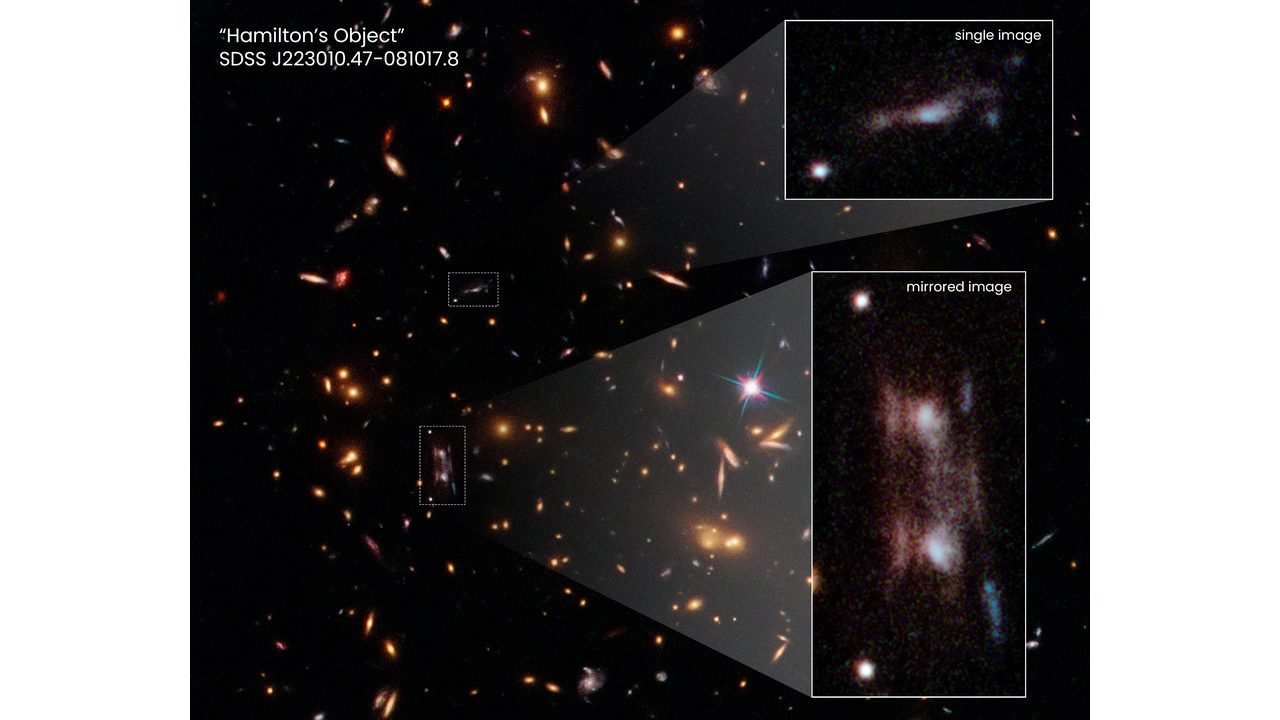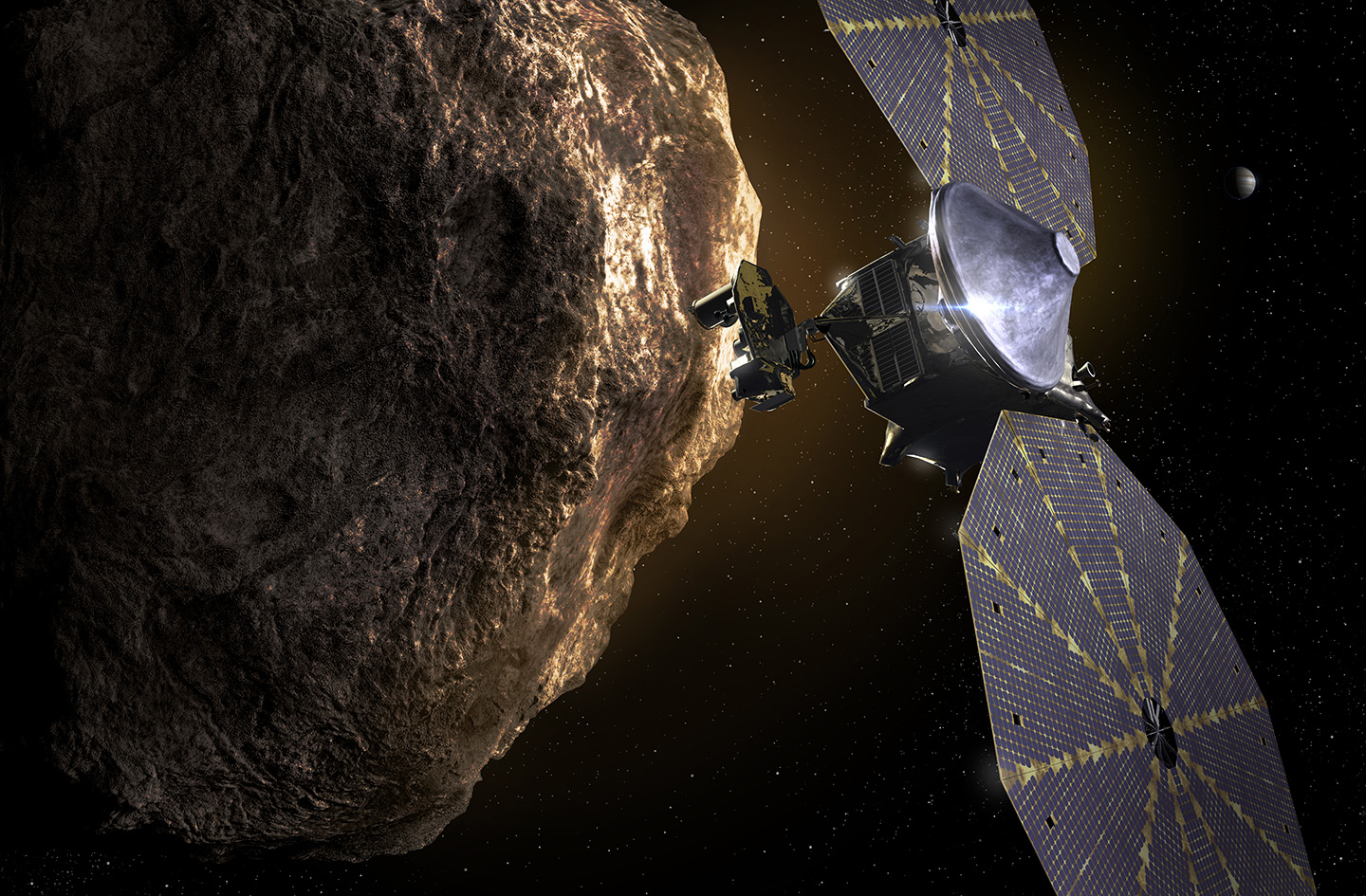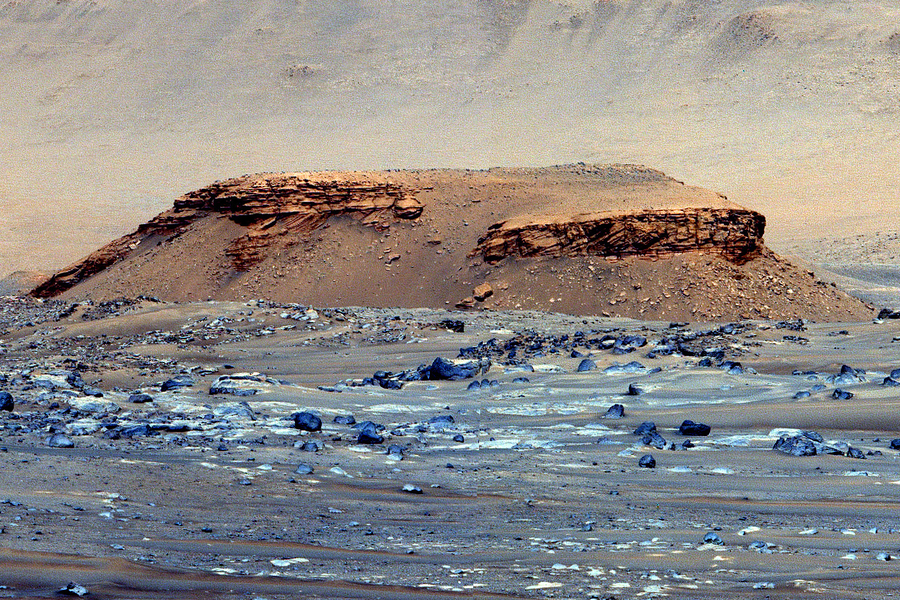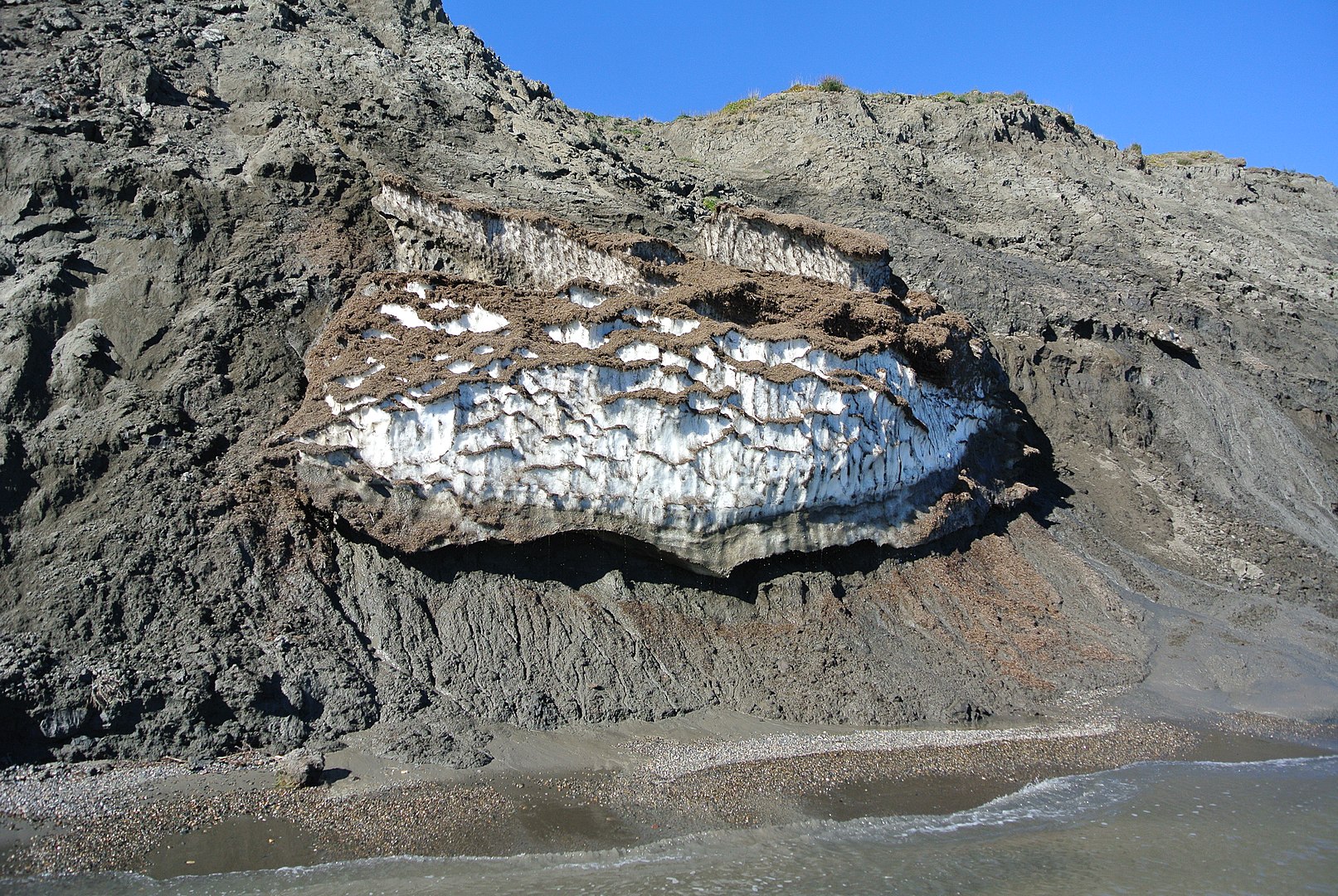A newly completed analysis of Perseverance’s first images from Mars finds that the landing site, Jezero Crater, was really a lake that was fed by a river, with sedimentary layers, flash floods, and strewn boulders. Plus, Central African biomass burning, Arctic permafrost melting, and we look at jewelry that celebrates upcoming missions.
Podcast
Show Notes
Small mountains formed without plate tectonics
- Extinct Style of Plate Tectonics Explains Early Earth’s Flat Mountains (Eos)
- “Enigmatic Mid-Proterozoic Orogens: Hot, Thin, and Low,” Christopher J. Spencer, Ross N. Mitchell, and Michael Brown, 2021 July 30, Geophysical Research Letters
Mirrored galaxies smudge Hubble Images
- Hubble press release
- “Hamilton’s Object – a clumpy galaxy straddling the gravitational caustic of a galaxy cluster: constraints on dark matter clumping,” Richard E Griffiths et al., 2021 May 17, Monthly Notices of the Royal Astronomical Society
NASA’s Lucy mission launch window opens October 16
- NASA press release
- NASA’s Lucy Mission to the Trojan Asteroids (Unistellar Optics)
Percy images confirm Jezero Crater as ancient lake
- ASU press release
- MIT press release
- University of Florida press release
- “Perseverance rover reveals an ancient delta-lake system and flood deposits at Jezero crater, Mars,” N. Mangold et al., 2021 October 7, Science
Push to ease planetary protection rules published
- NASEM press release
- PSI press release
- “Report Series: Committee on Planetary Protection: Evaluation of Bioburden Requirements for Mars Missions,” National Academies of Sciences, Engineering, and Medicine, 7 October 2021, The National Academies Press
Central African fires increase black carbon risk
- University of Exeter press release
- “Climate models generally underrepresent the warming by Central Africa biomass-burning aerosols over the Southeast Atlantic,” Marc Mallet et al., 2021 October 8, Science Advances
Climate change thaws out remnants of the past
- Melting permafrost in the Arctic could release radioactive waste and awaken sleeping viruses (Live Science)
- “Emergent biogeochemical risks from Arctic permafrost degradation,” Kimberley R. Miner et al., 2021 September 30, Nature Climate Change
Upcoming JWST and Lucy launches inspire jewelry makers
- James Webb Space Telescope collection (Science Socks)
- James Webb Space Telescope collection (includes 10% off code) (Startorialist)
Transcript
Hello and welcome to the Daily Space. I am your host Dr. Pamela Gay.
And I am your host Beth Johnson.
And we are here to put science in your brain.

When you think of mountains, you probably think of tall rocky edifices, soaring to great heights, like the Himalayas, the Rockies, the Andes, etc. And all of these mountains are due to modern plate tectonics, with plates running into one another and either uplifting vast tracts of land or subducting down and giving rise to high-reaching volcanic peaks. But Earth didn’t always have the plate tectonics it does today.
New research published in Geophysical Research Letters provides geochemical evidence that continental rocks in the Proterozoic era, about 1.8 billion to 850 million years ago, weren’t thick enough for the kind of mountain building we see in the recent geologic past. In fact, it was less than 40 kilometers thick and very hot compared to today’s continental crust. However, these same rocks had signs of metamorphic minerals — minerals that formed under similar types of pressures and temperatures that signify mountain building.
Despite the thin, hot crust, mountain formation was possible as bits of young, relatively weak crust slid past itself, with glancing blows rather than the head-on collisions we see in places like India today. Those glancing blows were enough on a geologic time scale to cause the formation of lower, flatter mountain ranges than I mentioned earlier. Lead author Christopher Spencer sums the research up: Mountains during the Proterozoic were different from mountains at any other time in Earth’s history.

Making sense of the universe is an ongoing struggle, and the more we look, the more we find that we need to understand. Some mysteries are nearby, like Venus’ weird “days are longer than years” rotation. Others force us to try and understand what is going halfway across the universe.
Observations of the galaxy cluster <deep breath> SDSS J223010.47-081017.8 <exhale> uncovered a super weird splotch that looks rather like someone scraped a paint knife against the canvas of the universe. Close analysis of this splotch revealed they are essentially mirror images of one another and significantly more distant than the galaxy cluster that was being imaged.
When we see weird-looking objects in the field of a galaxy cluster this can only mean one thing: gravitational lensing. The mass of the galaxy cluster bent light intended for another corner of the universe toward us, allowing us to see a distorted image of that distant galaxy. This is like using a funhouse mirror to look around a corner – a magnifying funhouse mirror.
Gravitational lenses aren’t unusual, but this particular system is unusual in how it produces twin images that are reversed. After a lot of head-scratching and phone calls to collaborators, it was realized this situation could be explained if the distant galaxy aligns with a dense ripple of dark matter that lens the galaxy’s light the way waves on a pool act like lenses to create bright patterns of sunlight on the bottom of a pool.
In addition to the mirrored images, the mass in the cluster also creates a third image of the background galaxy. This is the only lensed object in this system. These results were published in the Monthly Notices of the Royal Astronomical Society and led by Richard Griffiths.

While ancient tectonics and gravitational lensing are interesting subjects, there is nothing quite like a new space mission to get people excited, and the end of this year is hoping to bring us all the major launches. First up, NASA’s Lucy mission is scheduled to launch no earlier than Saturday, October 16 at 5:34 am EDT.
Lucy, named for the famous fossil discovered in Ethiopia, is going to study several of the Trojan asteroids in orbit with Jupiter. There are two swarms of these Trojan asteroids, with one trailing Jupiter in the L5 Lagrange point and one leading Jupiter in the L4 Lagrange point. This mission is pretty cool because Lucy is going to basically make figure eights in space and visit seven Trojan asteroids plus one main-belt asteroid over twelve years.
That main-belt asteroid is called 52246 Donaldjohanson and is named for the scientist that discovered the Lucy fossil. And as we learned a lot about the evolution of humanity from that one fossil find, so too, do we hope to learn about the evolution of our solar system from these asteroids.
We’ll bring you more coverage of the upcoming launch and its mission here on Daily Space, so make sure to follow our social media channels for announcements, stories, and possibly even a live launch stream.
It feels like just yesterday that I spent several hours covering the landing of the Perseverance rover on Mars with my colleagues over at the SETI Institute. In fact, Percy touched down way back in February, over seven months ago. And at the same time, we’ve covered so many Percy stories and so much has happened in our lives since then, that it also feels like Perseverance has been on Mars for years. Funny how time works, isn’t it?

But while we’ve all been dealing with the wild reality in which we are living, the science has continued to flow, and now a first major analysis of images taken by Percy has been published in the journal Science. That analysis provides evidence that Jezero Crater, Percy’s landing site, really is the site of an ancient lake, as we hoped.
In case you have been living under one of the fascinating rocks Percy has been photographing, Mars once had water. Lots of water. And Jezero Crater used to be a lake. We thought this was the case from images taken by the spacecraft in orbit around Mars, but now that we have images from inside the crater, we are certain. Well, as certain as a scientist without an actual time machine can be, but the evidence certainly is plentiful.
First, there is the Kodiak outcrop. Images show distinct sedimentary layers, and the images are so detailed that researchers could measure the thickness, slope, and even length of each layer. Based on that data, they concluded that the layers were deposited by flowing water. And there is even a fan-shaped formation just like we find here on Earth from river deposits into bodies of water.
Second, the images of the landing site showed numerous large boulders strewn about and even embedded in the layers, which means they had to come from somewhere else. Per one press release on the results: Judging from their current location and dimensions, the team says the boulders were carried downstream and into the lakebed by a flash flood that flowed up to 9 meters per second and moved up to 3,000 cubic meters of water per second.
These boulders could represent the transition from wet planet to dry planet, with those flash floods being a big piece of the climate change puzzle in the middle. We’ll learn more as Percy moves about and samples rock, although we might have to wait a few years before those rocks come to Earth.

A newly published report from the National Academies of Sciences, Engineering, and Medicine seeks to simplify the planetary protection requirements for certain locations on Mars in order to allow robotic missions access to key sites where evidence of life might exist.
PSI senior scientist Amanda Hendrix, who is also the co-chair for the Committee on Planetary Protection, explains: Currently, meeting planetary protection requirements – for instance, using rigorous sterilization techniques – can be seen as imposing, costly and complex, and it could be that these restrictions can be simplified and modernized, in some cases, which can help make some areas of Mars more accessible. The report suggests techniques for modernizing and providing flexibility in planetary protection implementation. One way to do this is by utilizing a risk management approach that could be tailored to individual missions’ needs. The Committee’s findings can lead to making portions of Mars more accessible to both commercial and government endeavors by relaxing planetary protection requirements while remaining careful about access to potential habitable zones.
That isn’t to say that the report says to throw away all the planetary protection requirements. Missions should still be a conservative distance from places where the subsurface of Mars could be accessed, such as cave openings. And missions would still have to go through standard aerospace cleanroom practices to avoid bringing contaminants as much as possible.
These proposed changes would only apply to NASA missions, not commercial missions or missions from other nations in which NASA does not participate. And there are still issues with the Outer Space Treaty (remember, that’s a thing) to deal with. We’ll see where this proposal leads, but it might be years before it affects any possible missions.
The environments of worlds are constantly changing for many different reasons. And here on Earth, some of those reasons are us. Understanding how humans are causing our world to change is an ongoing struggle, and the more we look, the more complexity we find. The Nobel Prize for Physics went to the complex system analysis that was needed to just start to understand Climate change!

Part of what makes everything so complicated is the need to understand the thermodynamic properties of everything sunlight touches. On the surface of our world, we have to understand how sunlight is reflected and absorbed by plants, lakes, oceans, ice, snow, dirty snow, deserts, and everything. Above our world, we have to understand the roles of clouds, pollutants, and naturally occurring junk like ash at every altitude. And at every point around our world.
Sunlight and the atmosphere interact in different ways in different parts of our atmosphere and affect the weather and the flow of heat in different ways. New research published in the journal Science Advances and led by Marc Mallet finds that some of the most used climate models fail to fully factor in the effects of aerosols from burning biomass – the burning of forests and savanna to make way for agriculture, as well as the burning of agricultural waste.
When you burn biomass, brown and black carbon is released as aerosols and can rise up through the atmosphere. These dark particles hold onto the Sun’s heat and warm the surrounding atmosphere. This study looked specifically at biomass burning in Central Africa and the effects it had in the Southeast Atlantic and the northern African weather. They find that current models are not able to reproduce the strong warming effect seen at the top of the atmosphere and under-predict the formation of low-level clouds which are important in calculating the Earth’s balance between reflecting and absorbing sunlight.
Put another way, aerosols are heating the upper atmosphere, but they are also part of the reason more clouds are forming than predicted, and those clouds reflect incoming sunlight. This is a complex system, and to get a handle on it, they point out that measurements from aircraft yield more accurate data for models.
This all feels kind of far away from our studio here in the middle U.S., but if you find that weather predictions aren’t as accurate as they used to be, what you’re seeing is a combination of we don’t have the same quality data we used to have and as climate change ramps up, our past understanding of the atmosphere no longer applies. The next decades are going to be difficult for meteorologists and heartbreaking for many who have to live through the planet’s harsher storms and more extreme temperatures.
About twenty years ago, folks more often said global warming rather than climate change, but as we’ve realized that some places are going to be plagued by unusually cold weather and that overall, we’re seeing chaotic changes around the average temperature, using the phrase climate change just seemed to make more sense. While the overall planetary temperature may be going up fractions of a degree, some places will see 5-degree decreases while others see 4-degree increases.

The northern polar regions are one of the fastest-warming, and the effects of this warming are hazardous in ways I hadn’t realized. According to a new paper in Nature Climate Changethat was led by Kimberley Miner, the thawing of permafrost is going to release a whole lot of hazards we thought we had safely frozen away.
Folks have been discussing the release of viruses and bacteria from thawing cemeteries. There has been concern expressed that the revealed bodies of cave lions and wooly mammoths could bring biological dangers with their cute, fuzzy, frozen faces as they appear in the melting landscape. Now we realize that humans’ tendency to bury garbage brings a new concern: radiation. The U.S.’s Camp Century deposited nuclear waste from its power station into the ice, which is now retreating. A crashed B-52 carrying nuclear weapons left uranium and plutonium in a Greenland ice sheet. Both the U.S. and USSR conducted nuclear testing in the arctic
And the radiation is joined by heavy metals left from mining, with mercury, arsenic, nickel, and other pollutants now seeping out of the ice they were trapped within and into the soils and groundwater beneath. Pollutants from the past – DDT, PCBs and other toxins – that settled out of the atmosphere and into the now-melting snow are also present and getting concentrated as many decades of captured pollutants melt at once.
The melting permafrost is such an environmental catastrophe that I lack words to explain it. Study author Miner simply states: It’s absolutely critical to make sure that we do everything in our power to keep the permafrost — and generally the Arctic — frozen.
It may be too late, but if we can change the global industrial complex, somehow, maybe, maybe, we can put the brakes on this melting catastrophe. Maybe.
Review

[No transcript available.]
This has been the Daily Space.
You can find more information on all our stories, including images, at DailySpace.org. As always, we’re here thanks to the donations of people like you. If you like our content, please consider joining our Patreon at Patreon.com/CosmoQuestX.
Credits
Written by Pamela Gay and Beth Johnson
Hosted by Pamela Gay and Beth Johnson
Audio and Video Editing by Ally Pelphrey
Content Editing by Beth Johnson
Intro and Outro music by Kevin MacLeod, https://incompetech.com/music/

 We record most shows live, on Twitch. Follow us today to get alerts when we go live.
We record most shows live, on Twitch. Follow us today to get alerts when we go live.